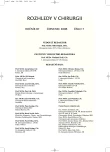Ischemic Affection of the Spinal Cord as a Result of the Blunt Thoracic Trauma – A Case Report
Authors:
K. Šmejkal 1; I. Žvák 1; T. Holeček 2; P. Habal 3; P. Lochman 1
Authors‘ workplace:
Katedra válečné chirurgie, Fakulta vojenského zdravotnictví UO Hradec Králové
vedoucí katedry: doc. MUDr. L. Klein, CSc.
1; Chirurgická klinika FN a LF UK Hradec Králové, přednosta kliniky: doc. MUDr. A. Ferko, CSc.
2; Kardiochirurgická klinika FN a LF UK Hradec Králové, přednosta kliniky: doc. MUDr. J. Harrer, Ph. D.
3
Published in:
Rozhl. Chir., 2008, roč. 87, č. 7, s. 344-346.
Category:
Monothematic special - Original
Overview
Authors present the case of a patient who suffered the blunt thoracic trauma. In the clinical picture there dominated the paraplegia of both the lower extremities. Due to the weakened breathing on the right side the urgent thoracic drainage was performed. For circulation instability and amount of blood passing out of the drain an urgent thoracotomy was indicated even prior to the CT or MRI. During the operation bleeding from the Adamkiewicz’s artery was spotted and sanated. After the postoperative stabilization the CT and MRI investigations proved the spinal cord ischemia as a cause of the local damage.
Key words:
blunt thoracic trauma – Adamkiewicz’s artery – spinal cord ischemia
Sources
1. Giacobetti, F. B., Vaccaro, A. R., Mary, A., et al. Vertebral Artery Occlusion Associated With Cervical Spine Trauma: A Prospective Analysis. Spine, 1997; 22: 188–192.
2. Louw, J. A., Mafoyane, N. A., Small, B., et al. Occlusion of the vertebral artery in cervical spine dislocations. J. Bone Joint Surg., 1990; 72: 679–681.
3. Willis, B., Greiner, F., Orrison, W., et al. The incidence of vertebral artery injury after midcervical spine fracture or subluxation. Neurosurgery, 1994; 34: 435–442.
4. Fabian, T. C., Richardson, J. D., Croce, M. A., et al. Prospective Study of Blunt Aortic Injury: Multicenter Trial of the American Association for the Surgery of Trauma. J. Trauma, 1997; 42: 374–383.
5. Flores, J., Shiiya, N., Kunihara, T., et al. Risk of Spinal Cord Injury After Operations of Recurrent Aneurysm of the Descending aorta. Ann. Thorac. Surg., 2005; 79: 1245–1249.
6. von Oppel, U. D., Dunne, T. T., DeGreeot, M. K., et al. Spinal cord protection in the absence of collateral circulation: meta-analysis of mortality and paraplegia. J. Cardiac. Surg., 1994; 9: 685–691.
7. Lazorthes, G., Gouaze, A., Zadeh, J. O., et al. Arterial vascularization of the spinal cord: recent studies of the anastomotic substitution pathways. J. Neurosurg., 1971; 35: 253–262.
8. Rogers, F. B., Osier, T. M., Shackford, S. R., et al. Isolater Stab Wound to the Artery of Adamkiewicz: Case Report and Review of the Literature. J. Trauma, 1997; 43: 549–551.
Labels
Surgery Orthopaedics Trauma surgeryArticle was published in
Perspectives in Surgery

2008 Issue 7
Most read in this issue
- Pectoralis Maior Tendon Rupture and Anabolic Steroids in Anamnesis – a Case Review
- Re-expansion Pulmonary Edema as a Complication of a Spontaneous Pneumothorax Drainage – a Case Review
- Rare Cases of Extensive Retroperitoneal Liposarcomas
- Stents – Paliative and Curative Management of Esophageal Conditions. Seven-Year Surgical Experience
